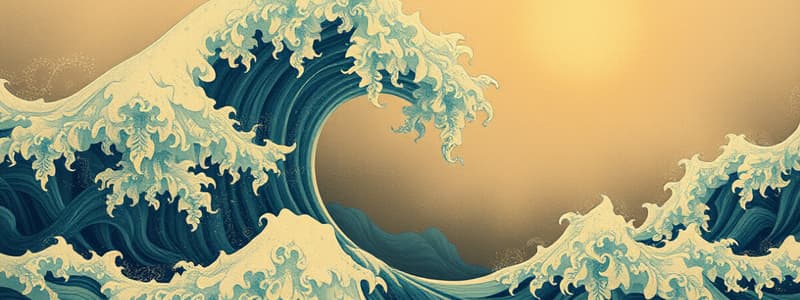Podcast
Questions and Answers
What are waves?
What are waves?
A wave is a disturbance that moves from one place to another.
What causes a wave?
What causes a wave?
An oscillator moving back and forth or a single disturbance.
Describe the motion of a buoy in the presence of a traveling water wave.
Describe the motion of a buoy in the presence of a traveling water wave.
The buoy moves approximately up and down while the wave moves forward.
What are the two basic types of waves studied?
What are the two basic types of waves studied?
What are transverse waves?
What are transverse waves?
What are longitudinal waves?
What are longitudinal waves?
What are the variables used to describe a wave?
What are the variables used to describe a wave?
How do you measure the amplitude of a longitudinal wave?
How do you measure the amplitude of a longitudinal wave?
What are beats and how are they created?
What are beats and how are they created?
What is the shape of a sound wave?
What is the shape of a sound wave?
Why do water waves break near the beach?
Why do water waves break near the beach?
What is the relationship between wave speed, frequency, and wavelength?
What is the relationship between wave speed, frequency, and wavelength?
What is a sound wave?
What is a sound wave?
What is superposition of waves?
What is superposition of waves?
What is a standing wave?
What is a standing wave?
How do you create standing waves on a string?
How do you create standing waves on a string?
How many wavelengths of a standing wave can fit on a string?
How many wavelengths of a standing wave can fit on a string?
How many wavelengths of a standing wave can fit in a tube of air with one end closed?
How many wavelengths of a standing wave can fit in a tube of air with one end closed?
What is the Doppler effect?
What is the Doppler effect?
Flashcards are hidden until you start studying
Study Notes
Overview of Waves
- A wave is a disturbance that transmits energy and momentum through a medium without carrying matter forward.
- Particles in matter oscillate while the wave travels onward.
Causes of Waves
- Waves are generated by oscillators or single disturbances, like a vibrating tuning fork or a pebble thrown into water.
Buoy Motion in Water Waves
- A buoy anchored underwater moves up and down as water waves pass but does not travel with the wave itself.
- Water molecules also move in circular motions, not along with the wave.
Types of Waves
- Two fundamental types of waves: Transverse and Longitudinal.
Transverse Waves
- These waves oscillate perpendicular to their direction of travel.
- Found in solids and liquids; light is an example, which can travel through a vacuum.
Longitudinal Waves
- Oscillate parallel to their direction of travel and can occur in solids, liquids, and gases.
- Known as pressure waves due to their compressive nature (e.g., sound waves).
Wave Variables
- Wavelength: Distance between two consecutive peaks (transverse) or compressions (longitudinal).
- Frequency: Number of peaks passing a fixed point per second; controlled by the oscillator's frequency.
- Amplitude: For transverse waves, it’s the height from equilibrium to peak; for longitudinal waves, it’s related to molecular compression, not a distance measure.
- Wave Speed Formula: Speed = frequency x wavelength; faster in denser materials.
Amplitude Measurement in Longitudinal Waves
- Amplitude is tied to the level of molecular compression, not a distance metric like in transverse waves.
Beats Phenomenon
- Created when two sound waves of slightly different frequencies interfere, resulting in fluctuations in sound intensity, characterized by beat frequency determined by the difference in source frequencies.
Sound Wave Characteristics
- Sound waves are three-dimensional, radiating in all directions.
Wave Behavior Near Shore
- Water waves break as they approach the shore due to decreasing depth, causing increased amplitude and decreased wavelength, ultimately leading to curling crests.
Sound Wave Definition
- Sound waves are longitudinal waves traveling through solids, liquids, or gases, with speed varying based on material density.
Superposition of Waves
- When multiple waves travel through the same medium, they overlap without disturbance, creating a resultant wave characterized by constructive (maximum) or destructive (minimum) interference.
Standing Waves
- Appear stationary, often in strings and air columns; created by reflecting waves canceling or enhancing each other at nodes (no motion) and antinodes (maximum motion).
Wavelengths in Fixed-Ended String
- Only harmonics that lead to standing waves persist; the first few harmonics relate to specific fractions of the wavelength.
Wavelengths in Closed-End Air Columns
- A tube closed at one end supports odd harmonics, with different fractions of wavelengths fitting according to harmonic number.
Doppler Effect
- Occurs due to relative motion between the sound source and observer, resulting in perceived frequency changes; a source moving away yields a lower pitch, while approaching yields a higher pitch.
Studying That Suits You
Use AI to generate personalized quizzes and flashcards to suit your learning preferences.




